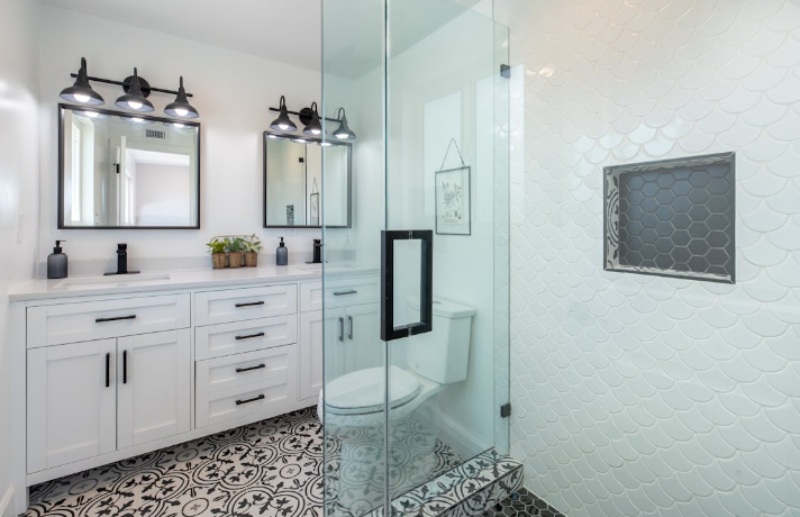Home
Common BathroomRemodeling Mistakes and How to Avoid Them

In a city like Seattle, where property values are constantly rising, bathroom remodels have become a favorite renovation project. Many homeowners in the area are eager to upgrade their outdated spaces into modern, functional bathrooms. However, while the process might seem straightforward, it’s easy to fall into traps that can derail the project. Whether it’s underestimating costs, overlooking crucial details, or being swayed by fleeting design trends, these common mistakes can turn your dream bathroom into a costly headache.
This article will guide you through the top mistakes people make when remodeling their bathrooms and, more importantly, how you can avoid them to ensure a smooth and successful project. From planning to material selection, these tips will help Seattle homeowners stay on track and achieve the bathroom of their dreams.
1. Attempting Complex Remodels Without Hiring a Professional
Many homeowners try to tackle their bathroom remodel themselves to save money, but this can be a costly mistake, especially for complex renovations. While DIY projects are fine for minor cosmetic updates, a full-scale bathroom remodel involves intricate work such as plumbing, electrical wiring, and tiling that requires expert skills. Attempting these tasks without the right knowledge can lead to mistakes that might cost you more in the long run to fix.
This is why it’s essential to hire a local Seattle bathroom remodeler who understands the city’s building codes, regulations, and climate considerations. Professional contractors can ensure that the project is done efficiently and up to code, giving you peace of mind. They also have access to high-quality materials and the expertise to deal with unexpected problems that may arise during the remodel. Hiring a qualified, experienced remodeler will save you time, money, and the frustration of dealing with costly mistakes.
2. Overlooking the Importance of Ventilation
Bathrooms are naturally damp spaces, and if not ventilated properly, they can quickly become a breeding ground for mold and mildew. Unfortunately, many homeowners make the mistake of either ignoring ventilation altogether or assuming that a small window will suffice.
In reality, effective ventilation is critical for maintaining a healthy bathroom environment. Without it, moisture can seep into your walls, ceilings, and flooring, causing long-term damage that’s expensive to fix. A poorly ventilated bathroom may also develop unpleasant odors, making the space far from relaxing.
When planning your remodel, be sure to include a high-quality exhaust fan to keep humidity levels under control. You might also want to consider adding a window to allow for natural airflow. This simple step can prevent future problems and ensure that your bathroom remains a fresh and comfortable space.
3. Prioritizing Trends Over Timeless Design
It’s easy to be tempted by the latest design trends when remodeling your bathroom. Whether it’s bold wallpaper, trendy fixtures, or eye-catching tiles, there’s no shortage of trendy options available. However, prioritizing trends over timeless design can be a costly mistake.
Trends come and go, and what’s in style today might look outdated in just a few years. If you plan to sell your home in the future, a highly stylized bathroom may not appeal to potential buyers, limiting your property’s resale value. Even if you’re planning to stay, constantly updating your bathroom to keep up with trends can become expensive.
To avoid this, focus on timeless design elements that will remain attractive and functional for years to come. This doesn’t mean you have to avoid trends entirely, but use them in moderation. Incorporate trendy features through easily changeable items like paint, accessories, or linens. This way, you can keep your bathroom looking fresh without committing to costly, permanent changes.
4. Forgetting to Plan for Sufficient Storage
A bathroom without enough storage can quickly become cluttered and disorganized. Many homeowners, in their excitement to create a sleek, modern bathroom, forget about one of the most important aspects of any functional space—storage.
Without enough storage, everyday essentials like towels, toiletries, and cleaning supplies can end up scattered around, ruining the aesthetic of your newly remodeled bathroom. Additionally, cluttered countertops can make the space feel smaller and less relaxing.
To avoid this mistake, carefully consider your storage needs before beginning the remodel. Built-in cabinets, shelves, and vanity storage are all excellent options to keep your bathroom organized. Even in small bathrooms, clever storage solutions can be incorporated to maximize the use of space. Don’t sacrifice functionality for aesthetics—plan your storage wisely to maintain a clutter-free environment.
5. Choosing the Wrong Materials for a Moisture-Prone Environment
The materials you choose for your bathroom play a significant role in its longevity and durability. Since bathrooms are high-moisture environments, using the wrong materials can lead to significant issues down the road. Some homeowners, in an effort to save costs, opt for materials that aren’t designed to withstand the damp conditions of a bathroom.
For example, using non-water-resistant wood flooring or the wrong type of paint can result in warping, mold growth, and other moisture-related damage. Additionally, certain types of tiles or countertops may become stained or damaged when exposed to water regularly.
To avoid these issues, always choose materials that are specifically designed for use in bathrooms. Waterproof tiles, mold-resistant paint, and durable fixtures will help ensure that your bathroom not only looks great but also stands the test of time.
6. Skimping on Fixtures and Finishes That Matter Most
In an effort to cut costs, some homeowners opt for cheaper fixtures and finishes, believing it will save them money. However, low-quality faucets, showerheads, and other fixtures tend to wear out faster, leading to leaks, water damage, and the need for costly replacements down the line. Choosing subpar finishes can also diminish the overall aesthetic of your bathroom, making it feel less luxurious and durable.
Instead of skimping, invest in high-quality fixtures that will stand up to daily wear and tear. Premium fixtures not only add a polished, upscale look to your bathroom but also provide better performance and longevity. While they may have a higher initial price, they can save you money in the long term by reducing maintenance and replacement costs. Choose durable materials for your sink, shower, and other high-use areas to ensure your remodel is built to last.
Bathroom remodels are an exciting way to refresh and enhance your home, but they come with a variety of potential pitfalls. By being aware of common remodeling mistakes—such as failing to plan properly, overlooking ventilation, prioritizing trends over timeless design, or choosing the wrong materials—you can save yourself time, money, and frustration. Working with a professional bathroom remodeler will ensure that the job is done correctly and that you avoid costly errors. Additionally, paying attention to essential details like lighting, water efficiency, and high-quality fixtures will help you create a space that’s not only beautiful but also functional and sustainable.
Whether you’re upgrading a small powder room or revamping a master bathroom, taking the time to plan carefully and avoid these mistakes will set you on the path to remodeling success.
Home
How Villa Projects in Hyderabad Are Redefining Modern Homes?

Hyderabad isn’t just a city. Instead, it’s a dynamic hub of innovation, culture, and endless possibilities. As the demand for premium living spaces skyrockets, homebuyers are no longer settling for just four walls and a roof. Instead, they seek homes that seamlessly blend comfort and sophistication. That’s why they are leaning more towards villa projects in Hyderabad, where each residence is a masterpiece of luxury, innovation, and grandeur, redefining the essence of modern living.
These homes go beyond traditional living, offering spacious layouts, world-class amenities, and a lifestyle tailored for those who crave the extraordinary. For those who want to upgrade their lifestyles, villas present an alternative that prioritises space, privacy, and opulence. But what makes these villa projects in Hyderabad stand out? Let’s take a closer look into the features, amenities, and benefits that are making them the future of modern housing.
Prime Locations with Exceptional Connectivity
One of the most compelling aspects of villa projects in Hyderabad is their strategic location. Positioned in rapidly developing suburbs such as Mamidapally, these projects ensure seamless connectivity to major business hubs, educational institutions, and healthcare centres. The Outer Ring Road (ORR) further enhances accessibility, making commuting hassle-free for professionals and families alike.
In addition to proximity to IT corridors and financial districts, these villa projects are surrounded by top-tier schools, hospitals, and entertainment hubs. Whether it’s an evening at a high-end shopping mall or a weekend escape to a resort, everything is within reach.
A Wealth of World-class Amenities
Modern villa projects in Hyderabad go beyond four walls; they offer a lifestyle with numerous premium amenities designed for leisure, wellness, and social engagement. From fitness to recreation, every aspect of life is catered to within these developments.
- Exclusive Clubhouse Facilities
- Reception Lounge and Café – A stylish space to unwind or meet guests
- Party Hall with Pantry – Perfect for hosting celebrations
- Day Care Centre – Convenient for working parents
- Gym, Functional Training, and Crossfit Corner – Ensuring fitness goals are met
- Yoga Room and Meditation Spaces – Promoting holistic well-being
- AV Room and Association Room – Spaces for community engagement and entertainment
- Indoor Entertainment and Recreation
- Indoor Game Corner, Video Game Arcade, and Kids Play Area – Fun for all age groups
- Ball Pit, Adventure Rock Climbing, and Lego Area – Keeping children engaged and active
- Interactive Wall Games and Gaming Zones – Modern entertainment options for residents
- Outdoor and Terrace Amenities
- Swimming Pool and Kids Pool with In-Pool Daybeds – Ideal for relaxation
- Outdoor Café, Party Lawn, and Dance Floor – Spaces for socialising and unwinding
- Multipurpose Sports Court and Golf Lawn – Encouraging an active lifestyle
- Amphitheatre and Movie Screening Wall – Bringing entertainment closer to home
- Reflexology Walkway and Senior Citizen Pavilion – Designed for holistic wellness
- Pet Park and Nature Trails – Getting close to the nature in everyday living
Security and Sustainability: Priorities of Modern Living
The increasing emphasis on security and sustainability has led to the integration of the latest safety features and eco-friendly initiatives in villa projects in Hyderabad.
- Advanced Security Features
- CCTV Surveillance – Installed at key locations for round-the-clock monitoring
- Security Booth with MyGate App – Ensuring controlled entry and exit
- Compound Wall with Entry Gates – Providing a secure environment for residents
- Sustainable Infrastructure
- Centralised Water Treatment and Rainwater Harvesting – Ensuring sustainable water usage
- Sewage Treatment Plant (STP) – Reducing environmental impact
- 100% Power Backup for Common Areas – Guaranteeing uninterrupted services
- Lush Green Landscaping – Adding to the aesthetic and environmental value of the community
These features are not only available in villa projects but also in flats to buy in Hyderabad, providing a sustainable and secure lifestyle that appeals to modern homebuyers.
Spacious Homes Designed for Elegance and Comfort
Villa projects in Hyderabad offer expansive layouts with private gardens, terraces, and open-air spaces. These residences are meticulously designed to balance aesthetics and functionality, featuring:
- High Ceilings and Large Windows – Enhancing ventilation and natural light.
- Private Balconies and Green Spaces – Creating tranquil retreats within the home
- Designer Kitchens and Elegant Interiors – Elevating everyday living
These villa projects in Hyderabad provide an unmatched sense of space and sophistication, making them an excellent long-term investment.
The Growing Investment Potential of Villas in Hyderabad
Real estate in Hyderabad has witnessed remarkable appreciation over the years, with villa projects gaining significant traction among investors and homebuyers alike. Factors driving this trend include:
- Rising Demand for Gated Communities – Preference for premium, self-sufficient townships
- IT and Business Growth – Attracting professionals seeking high-end living
- Upcoming Infrastructure Projects – Enhancing connectivity and accessibility
- Higher ROI and Rental Yields – Making villas a lucrative investment choice
Whether for personal use or investment, choosing a villa ensures long-term value, capital appreciation, and a premium living experience.
Elevate Your Lifestyle with Villa Projects in Hyderabad
The evolution of villa projects in Hyderabad is transforming the way homebuyers perceive modern living. With world-class amenities, strategic locations, and eco-friendly infrastructure, these communities offer an unparalleled lifestyle of comfort and exclusivity. Whether you are considering villas or flats to buy in Hyderabad, this city offers anything that you could imagine.
As Hyderabad continues to expand, now is the perfect time to invest in a villa project that blends luxury, convenience, and long-term value. Whether it’s the tranquillity of a green landscape, the vibrancy of community living, or the promise of a secure future, these homes offer it all. You can check the finest villa projects by reputed builders like Casagrand and step into a world where every detail is designed for your ultimate comfort and lifestyle.
Home
DIY vs. Professional Lawn Care: Which One Is Right for You?

A well-maintained lawn enhances the beauty of any home, but achieving lush, green grass requires consistent effort and the right approach. Homeowners often debate whether to handle lawn care themselves or hire professionals. Both options have their benefits and drawbacks, and the right choice depends on factors such as time, budget, and expertise. In this article, we’ll compare DIY and professional lawn care to help you decide which option suits your needs best.
DIY Lawn Care: Pros and Cons
Many homeowners prefer to take care of their lawns themselves. With some effort and knowledge, DIY lawn care can yield excellent results.
Pros of DIY Lawn Care
- Cost Savings – One of the biggest advantages of DIY lawn care is the potential for cost savings. You won’t have to pay for professional services, only for materials like fertilizers, seeds, and tools.
- Personal Satisfaction – Taking care of your lawn yourself can be rewarding. Seeing your hard work pay off in the form of a healthy, green lawn can be a source of pride.
- Flexible Schedule – You have full control over when and how you take care of your lawn, allowing you to work at your convenience.
- Customization – You can choose the specific products and methods that best suit your lawn’s needs rather than relying on a one-size-fits-all approach.
Cons of DIY Lawn Care
- Time-Consuming – Proper lawn maintenance requires regular mowing, fertilizing, aerating, and watering, which can take up a lot of time.
- Knowledge and Skill Required – Understanding soil types, grass varieties, and pest control methods is essential. A lack of knowledge can lead to mistakes that harm your lawn.
- Initial Equipment Costs – While DIY lawn care can save money in the long run, purchasing lawn care tools like mowers, spreaders, and aerators can be expensive.
Professional Lawn Care: Pros and Cons
Hiring a professional lawn care service can make maintaining your lawn easier and more effective, but it comes with its own considerations.
Pros of Professional Lawn Care
- Expertise and Experience – Lawn care professionals have the training and knowledge to diagnose problems and implement the best solutions for your yard.
- Consistent Maintenance – With scheduled visits, professional services ensure that your lawn is cared for regularly, preventing issues like weed overgrowth or patchy grass.
- Access to High-Quality Products – Professional lawn care companies often use commercial-grade fertilizers, herbicides, and pest control treatments that may not be available to homeowners.
- Time-Saving – Instead of spending weekends mowing and fertilizing, you can relax and enjoy your yard while professionals handle the work.
Cons of Professional Lawn Care
- Higher Costs – Professional lawn care services come at a price, and regular maintenance can add up over time.
- Less Control – When you hire professionals, you may have limited input on the products and techniques used.
- Scheduling Dependence – You may need to work around the company’s availability, which could sometimes be inconvenient.
Which Option is Right for You?
Choosing between DIY and professional lawn care depends on several factors:
- Budget: If cost is a concern, DIY lawn care may be the better option. However, if you’re willing to invest in high-quality lawn care, hiring professionals can save time and effort.
- Time Availability: If you have a busy schedule, professional lawn care can take the burden off your shoulders. If you enjoy gardening and have the time to dedicate, DIY may be more rewarding.
- Lawn Condition: If your lawn has serious issues such as pest infestations, weeds, or poor soil quality, a professional service like Yard Art Landscaping can provide expert solutions.
- Long-Term Goals: If you aim for a low-maintenance lawn, professionals can implement sustainable solutions that require less work in the future.
Final Thoughts
Both DIY and professional lawn care have their advantages and challenges. If you enjoy working outdoors and want to save money, DIY lawn care may be the right choice. However, if you want a perfectly maintained lawn without the hassle, hiring a professional service like Yard Art Landscaping can be a worthwhile investment. Assess your priorities, budget, and schedule to make the best decision for your lawn.
Home
Why Hiring Qualified Roofing Experts Is Essential for Your Property

Your roof is one of the most important parts of your home. It keeps you safe from rain, wind, and other weather. When your roof is damaged, it can lead to big problems. Hiring qualified roofing experts is the best way to protect your property. Here’s why it’s essential to hire the right people for your roof.
Quality Workmanship and Safety
Qualified roofing experts are trained to do the job right. They know how to install, repair, or replace roofs safely. Roofing can be dangerous. If you try to fix the roof yourself, you might hurt yourself or cause more damage.
An expert roofer has the right tools and experience to get the job done correctly. They understand how to handle the materials and protect your property. This ensures that your roof will last longer and function properly.
Saves You Time and Money
If you hire an unqualified roofer, it can cost you more in the long run. An expert roofer, such as experienced metal roofing installers, knows how to find and fix issues quickly. They will avoid mistakes that could lead to costly repairs.
By hiring a professional, you are more likely to get the job done right the first time. This saves you time because you won’t have to worry about redoing the work. Also, qualified roofing experts use high-quality materials that last longer, reducing the need for frequent repairs.
Proper Inspection and Diagnosis
A qualified roofing expert can give your roof a thorough inspection. They know what to look for and can spot problems that may not be obvious to you. Even if your roof looks fine, there may be hidden issues, like leaks or damage underneath the surface.
Roofing experts can diagnose problems early before they turn into bigger issues. Catching problems early helps you avoid costly repairs and ensures that your roof will continue to protect your home.
Insurance and Warranty Protection
When you hire a qualified roofing expert, you get the added benefit of insurance and warranties. Reputable roofing companies have insurance that protects you in case of accidents or damage. If something goes wrong during the roofing project, you won’t have to pay for it out of your pocket.
Additionally, many roof experts offer warranties on their work. This means that if something goes wrong with your roof after the work is done, they will come back and fix it at no extra cost. This added protection gives you peace of mind.
Compliance with Local Building Codes
Qualified roofing experts, including Tacoma roofing contractors, understand the local building codes and regulations in your area. This is important because improper installation can lead to fines or complications when you try to sell your home.
When you hire an expert, they make sure the work is done according to code. This ensures that your roof is safe, secure, and meets all the required standards.
Roofing Experts: Protect Your Home with a Professional Roofer
Your roof is crucial to your home’s protection. Hiring qualified roofing experts ensures that your roof is installed or repaired correctly and safely. They save you time and money, prevent further damage, and offer warranties for added security. Always hire an expert roofer to protect your property and ensure the longevity of your roof.
For more on this content, visit the rest of our blog!
-

 Entertainment11 months ago
Entertainment11 months agoBest Kickass Proxy List 2024 – 100% Working to Unblock to Access
-

 Lifestyle10 months ago
Lifestyle10 months agoBanging The Underdog Incident 2022
-

 Entertainment10 months ago
Entertainment10 months agoTamilMV Proxy Sites List 2025 – How to Unblock TamilMV Safely?
-

 Entertainment10 months ago
Entertainment10 months agoTamilRockers Proxy 2025: 20+ Working Links, Mirror Sites & VPN Guide
-

 Fashion8 months ago
Fashion8 months agoTrendy Midi Dresses for Casual Wear: Hair Care Tips Included!
-

 Entertainment10 months ago
Entertainment10 months agoPirate Bay Proxy List 2025: Access The Pirate Bay Safely
-

 Technology7 months ago
Technology7 months agoSSIS 469 – Detailed Guide to Understand The Features and Benefits
-

 Blog8 months ago
Blog8 months agoCy Kass – Family Detail of Alex Wagner and Sam Kass








